nature art
We’ll be learning about different artists whose inspiration is nature and creating some masterpieces of our own.
We’ll be learning about different artists whose inspiration is nature and creating some masterpieces of our own.
paint.
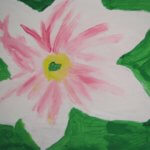 Georgia O’Keefe was an American artist who is famous for her landscapes of the desert southwest and her paintings of flowers. Click here to see examples of her artwork.
Georgia O’Keefe was an American artist who is famous for her landscapes of the desert southwest and her paintings of flowers. Click here to see examples of her artwork.
Today, we’re going to make paintings inspired by Georgia O’Keefe’s flower paintings.
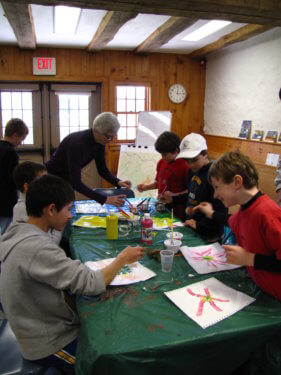 supplies:
supplies:
instructions:
Georgia O’Keefe was famous for painting flowers larger-than-life. Not only were her canvases large, but she painted the flowers so large on them that they often didn’t fit on the canvas! Paint or draw your flower so big that it goes off the edge of your paper, so that you’re filling the whole paper with color.
nature id.
Today’s nature id challenge is found along streams and in wet woods. There may be hundreds of individual plants in an area, so the leaves form a ground cover, but only a few of them will actually produce blooms.
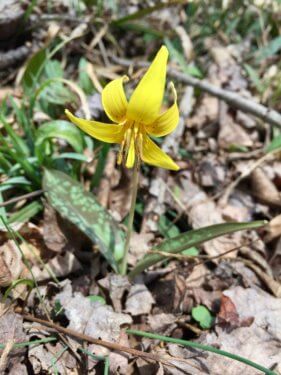
Answer: This is trout lily (Erthronium americanun). The common name is somewhat misleading, as this is not actually a lily (nor is it a trout). Although the flower may look like something in the lily family, it’s actually in the violet family. As for the “trout” part of the name—that most likely comes from the mottled leaves, which look a little like fish scales.
play.
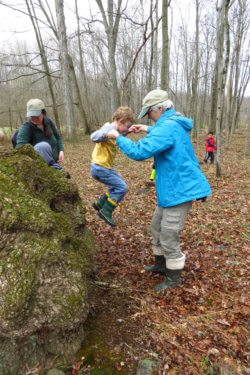 Find something to jump off of outside. It could be a stone, log, or just jump in the air on the trail.
Find something to jump off of outside. It could be a stone, log, or just jump in the air on the trail.
To be safe, only jump off from as high as you feel safe. It’s always a good idea to ask for a helping hand. You can always go back and jump again without help once you feel comfortable.
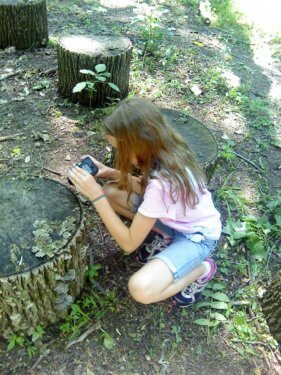 Nature is an amazing subject for a photo. Even if you live in a place without a lot of trees, you can always look up at the sky for interesting clouds, amazing sunsets, and maybe even a rainbow.
Nature is an amazing subject for a photo. Even if you live in a place without a lot of trees, you can always look up at the sky for interesting clouds, amazing sunsets, and maybe even a rainbow.
nature photography.
There are LOTS of great nature photographers out there (and today you’ll become one) so it’s hard to pick just one artist to feature, but here are a few for inspiration:
For today’s activity, head outside with a camera (a phone camera is fine) and start taking pictures. Flowers, leaves, and insects make great subjects. Try taking a picture from far away and then get as close as you can. For an extra challenge, pick a color and try taking photos of everything you see in that color.
If you don’t have access to a camera, make a frame out of cardboard and use it to frame the pictures you would take if you had a camera.
nature id.
Today’s nature id challenge is another woodland wildflower. This beautiful, delicate flower shakes in the slightest breeze.
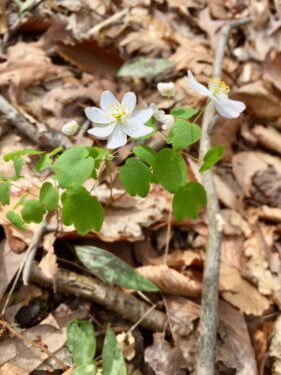
Answer: This flower is rue-anemone (Thalictrum thalictroides or Anemonella thalictroides). Like yesterday’s flower, rue-anemone is another case where the common name is misleading, as it’s not actually a true anemone—it’s in the buttercup family.
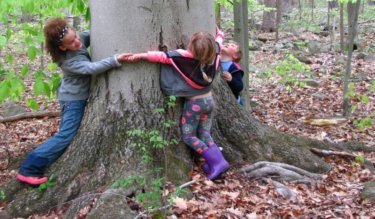 play.
play.
Go hug a tree! We firmly believe that everyone should be a treehugger!.
Today we’re going to create pictures out of what we find in nature.
create art with nature.
Flora Forager is a Seattle-based artist who makes beautiful pictures out of natural materials. She uses flower petals and other materials she finds outside to create pictures of entirely different things. You can see some of her amazing work on her website.
To create your own nature art you’ll need to head outside and gather materials—flowers, leaves, sticks, and stones, or whatever else you can find! Then, bring your materials inside and use them to create a picture. Be sure to take a photograph of your masterpiece when you’re done.
If you can’t go outside, try drawing things you would find in nature and then cut out and arrange the shapes you’ve made.
nature id.
This flower is tiny—note my hand in the picture for scale—but beautiful. Like the other wildflowers that have been highlighted this week, it’s a spring ephemeral, which means that it blooms early in the spring, before the trees have leafed out, when lots of sunlight still reaches the forest floor.
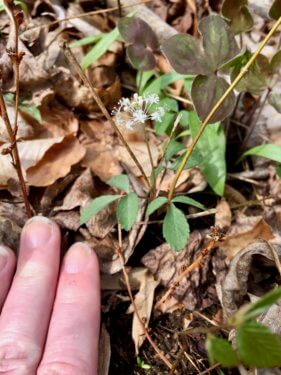
Answer: This is dwarf ginseng (Panax trifolius). It is related to true ginseng, which was traditionally used in Chinese medicine and is still used in many herbal remedies, but dwarf ginseng doesn’t share the medicinal properties of its relative.
play.
Go hunting for cool rocks. Rocks can be beautiful if you take the time to really look at them.

Mae Axelrod
Today’s outdoor fun is going to be magical.
fairy houses.
If you go for a walk in the woods, you might come across a tiny house built of sticks, stones, pinecones, or other natural materials. This is a fairy house—though these tiny residences could also be home to gnomes, insects, toads, or any other number of creatures, magical and non-magical alike.
Many artists make tiny houses for fairies and other magical creatures. One example is Mackworth Island in Maine, where an entire village of fairy houses has been built in the woods. See pictures of the houses here.
For the past few years at ChesLen Preserve, volunteers have been building fairy houses every summer to decorate Ollie Owl’s NaturePlayGround. Made with recycled materials, moss, wood, sticks, and glue, these fairy houses bring a bit of magic to the outdoors. It’s fun to imagine the what magical creatures would do if they lived in our neighborhood.
For today’s activity, head outside and find a spot that would be a good site for a fairy house. Fairies are known for liking their houses to be at the base of a tree or tucked into a nook or cranny, but you might find some other setting that looks good. Once you have your site, get building. Uses natural materials like sticks, stones, grasses, and so on to make and decorate your home. Once you’re finished, take a picture of your fairy house, then leave the area…the magical critters won’t move in if people are still around!
nature id.
Another beautiful spring ephemeral woodland wildflower for today’s ID—things are blooming so fast right now our ID challenge can’t keep up.
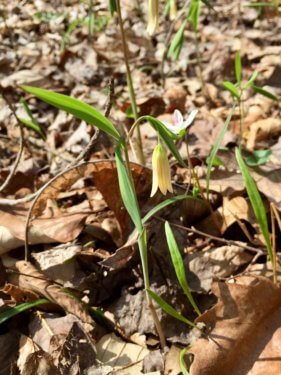
Answer: This is wild oats or sessile bellwort (Uvularia sessifolia).
play.
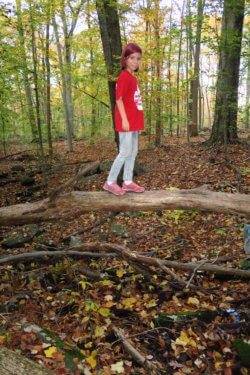 Find a natural balance beam out in the woods. Flat rocks and fallen trees are lots of fun to balance on.
Find a natural balance beam out in the woods. Flat rocks and fallen trees are lots of fun to balance on.
chalk art.
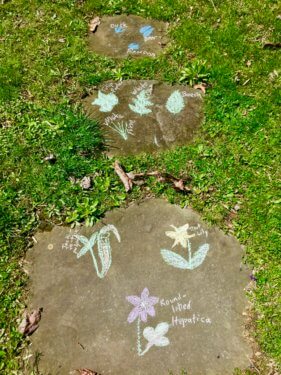 You may have read stories or seen pictures of people making drawings or writing messages in chalk on the sidewalk to make people smile. Today, that’s what we’re doing.! Grab some chalk and head outside to draw on the sidewalk or driveway (just be sure you’re somewhere safe without any cars). You can even use this project to share what you’ve learned about nature this month by drawing some of the flowers, trees, and animals that we’ve talked about in our activities.
You may have read stories or seen pictures of people making drawings or writing messages in chalk on the sidewalk to make people smile. Today, that’s what we’re doing.! Grab some chalk and head outside to draw on the sidewalk or driveway (just be sure you’re somewhere safe without any cars). You can even use this project to share what you’ve learned about nature this month by drawing some of the flowers, trees, and animals that we’ve talked about in our activities.
If you can’t get outside, don’t have any chalk, or don’t have a good place to draw, find some other way of sharing your nature art—like posting the pictures of the masterpieces you’ve created this week on social media.
nature id.
Today’s challenge is a tiny little flower. Even though it’s tiny, it smells incredible if you get your nose close enough.
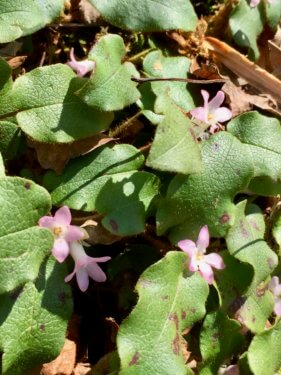
Answer: This is trailing arbutus (Epigaea repens). This flower used to be much more common, but it was heavily picked in the 1920s for use in decorative bouquets, and became much less common as a result. In fact, the flowers used to be a bit bigger, but the bigger blooms were picked more often, creating a selective pressure that resulted in smaller blooms becoming more common.
play.
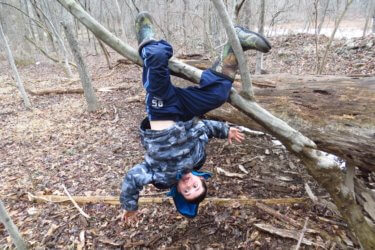 Go hangout outside for a while…but maybe not quite as literally as the kid in the picture.
Go hangout outside for a while…but maybe not quite as literally as the kid in the picture.